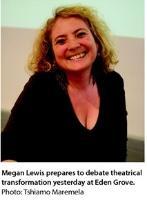
Vesterday's 40 Years of Theatre in SA panel discussion at Think!Fest ended on a note of disagreement — a good sign for the theatre.
This is a year for reflection, for exploring how theatre has evolved, how it has responded to democracy, how it has moved reconciliation forward — or if indeed any of these things have happened. Also, has theatre contributed to social cohesion, or does it merely reflect the still fragmented society we each experience every day?
In an interesting twist, two of the panellists were from foreign universities, both offering the perspective of the outsider. Though both, of course, are insiders in terms of academic study of the subject of South Africa's theatre development.
The first speaker, Dr Marcia Blumberg, of Canada's York University, explored the theme of Staging the Truth and Reconciliation Commission. She explored how the works of William Kentridge (Ubu and the Truth Commission), Craig Higginson (Dream of the Job), Yael Faber (He Left Quietly) and Lara Foot (Solomon and Marion) problematise reconciliation.
These theatre-makers have made the point that reconciliation is not something a nation can do without each individual going through the personal process first. Blumberg also pointed out the continued relevance of these pieces here and abroad, especially as South Africa's model of the TRC has been adopted in so many other places around the world.
The second speaker, Heike Gehring of Rhodes University, explored the rise and contribution of Gary Gordon's First Physical Theatre Company in creating a new way of communicating that transcends language. She linked the genesis of physical theatre to that of workshop theatre where, from the first day of rehearsals, the space becomes like a laboratory where negotiation and experimentation can take place.
She highlighted the biographical aspect of the discipline and how this adds to its relevance for audiences. She cited Brett Bailey's Third World Bunfight, Andrew Buckland and the Handspring Puppet Company as examples of those who have created new ways of performing with physical theatre.
The third speaker, Dr Megan Lewis, of the University of Massachusetts, offered an interesting insight into what works on the international market and the history of SA theatre on the American and British theatre circuits. Athol Fugard is the best-known playwright in America, she said, as his work allows Americans to vicariously speak truth to power and explore race relations in a safe space.
Yael Faber, whose Mies Julie was the toast of New York last year, is another South African playwright whose work strikes a chord in America, said Lewis, perhaps just for the sexiness factor. She also discussed the importance of works such as Exhibit A and Exhibit B, Brett Bailey's installation that was produced for a European audience to remind them of a history they have chosen to forget.
When Dr Samuel Ravengai, of Wits University, stood up to speak there was one unintended consequence — he was the only black speaker, left till last, which became a metaphor for his topic.
He explored theatre's desire towards integration and a deliberate shift away from Western theatrical practices —taking on, unintentionally, the fact that all the theatre-makers the other three speakers had mentioned were white.
He identified three trends in SA theatre history — European works created by whites for whites, English-speaking whites and intellectual blacks collaborating to make theatre, and the Black Consciousness movement, concerned with the opposition of whiteness and blackness.
He said we have to try and move towards something new — theatre that is equally relevant to all, that is truly made with the free participation of everyone, and that has no inherent ideas about what is inferior or superior in terms of method or message.
He pointed out that there are 50 theatres in South Africa but only one, the relatively new Soweto Theatre, is in a township. His concept of a new way for theatre in SA is both utopian and revolutionary.
Unfortunately Ravengai had to race through his speech, but I think everyone would have liked to hear more and certainly many would have liked more time to argue his points with him.
Which, of course, brings us back to the point of Think!Fest: to foster debate and hopefully take it out of the confines of Grahamstown's rarefied air.
By Gayle Edmunds
Photo: Dr Megan Lewis prepares to debate theatrical transformation at Eden Grove.
Photo: Tshiamo Maremela
Source: Cue newspaper
